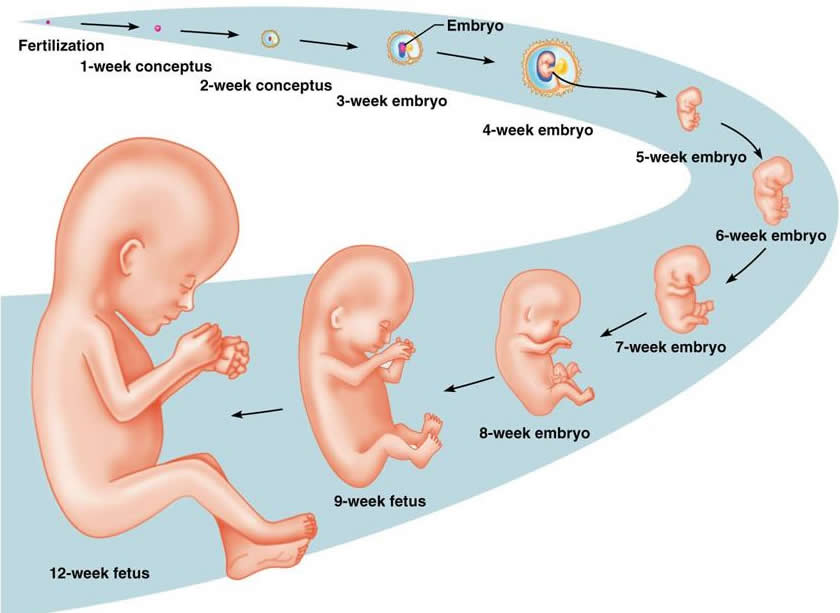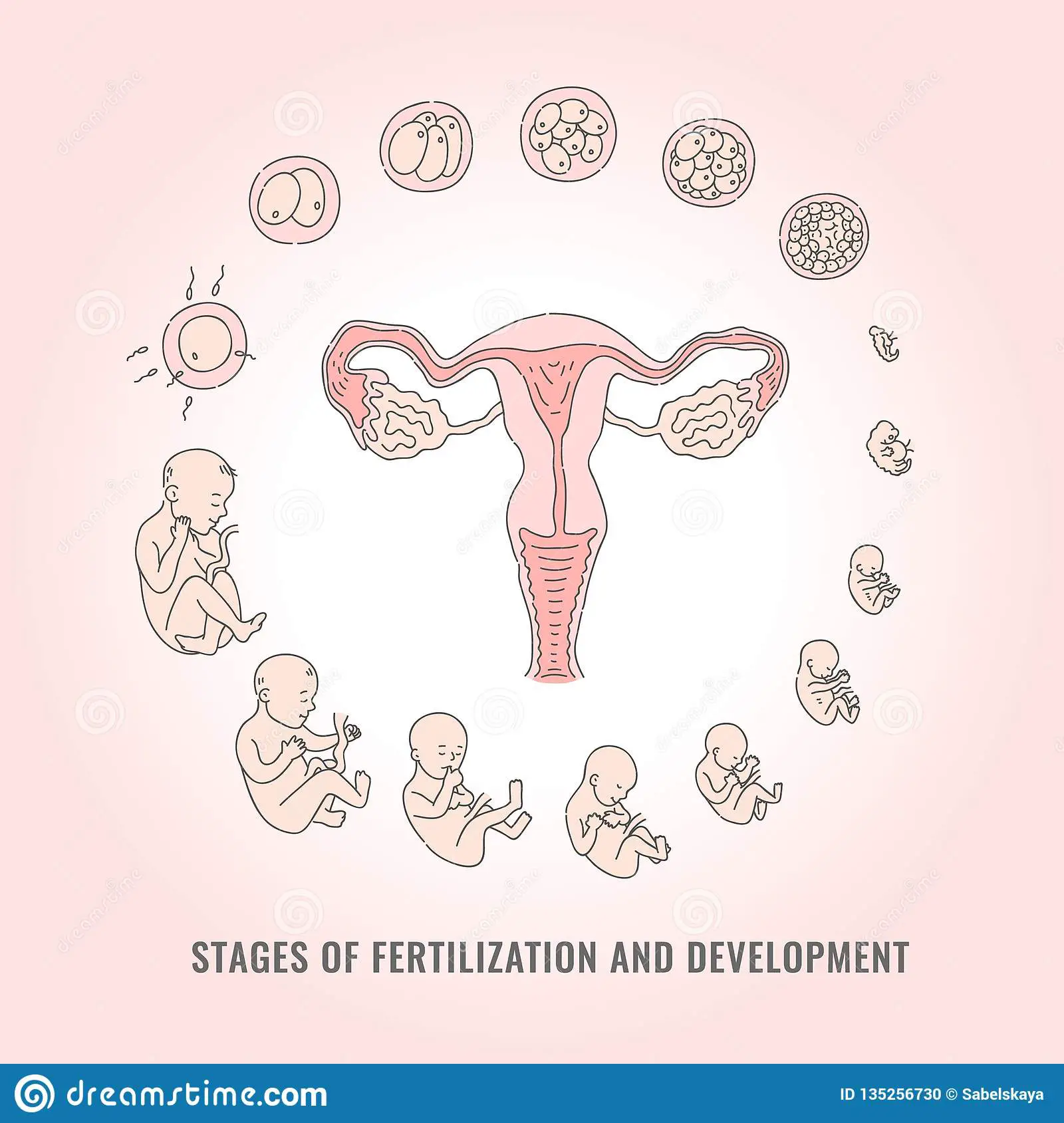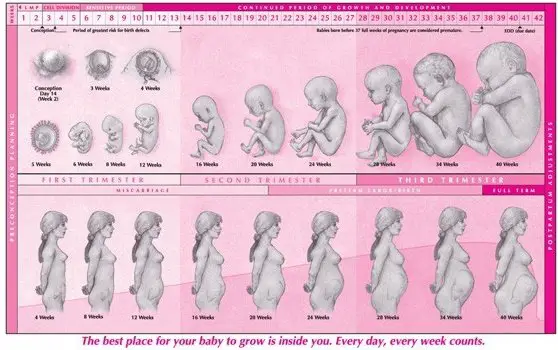Second Trimester Weeks 13
Second trimester changes in the mother:
Nausea and vomiting usually get better and go away, Burch told Live Science. But other symptoms may crop up as the fetus continues its growth and development.
Pregnant people will start to feel more pelvic pressure, Burch said, adding that the pelvis feels heavy like something is weighing it down.
A more visible baby bump appears as the uterus grows beyond the pelvis, and the skin over the expanding belly may itch as it stretches, according to the OWH.
As the fetus is getting bigger and the mother is gaining more pregnancy weight in the front of her body, she may also experience more back pain, Burch said. A 2020 study published in the Journal of Personalized Medicine found that while most pregnant people experienced back pain, it was worse in those who were not physically active.
Sometime between the 16th and 18th weeks of pregnancy, a first-time mother may feel the first fluttering movements of the fetus, known as quickening, Burch said. It it isn’t the first pregnancy, the mother is likely to feel the fetus kicking, squirming or turning even sooner because she knows what to expect, he said.
Second trimester fetal development:
In the second trimester, the fetus will be between 3 and 5 inches long, Burch said. Sometime between 18 and 22 weeks, an ultrasound may reveal the sex of the baby, if parents want to know this information in advance.
Related: Am I having a boy or girl? Ultrasound and sex prediction
First Trimester: Changes In A Woman’s Daily Routine
Some of the changes you experience in your first trimester may cause you to revise your daily routine. You may need to go to bed earlier or eat more frequent or smaller meals. Some women experience a lot of discomfort, and others may not feel any at all. Pregnant women experience pregnancy differently and even if they’ve been pregnant before. Pregnant women may feel completely differently with each subsequent pregnancy.
Implantation And The Start Of Pregnancy
Meredith Shur, MD, FACOG, is board-certified in obstetrics and gynecology, as well as a certified medical examiner.
Implantation is when a fertilized egg, or blastocyst, has attached to the lining of the uterine wall. It marks the beginning of pregnancy. The medical community, including the American College of Obstetricians and Gynecologists and the National Institutes of Health, agrees that a person is not pregnant until implantation has occurred. Medically speaking, successful implantation equals the start of a pregnancy.
You May Like: How To Calculate Safe Days To Avoid Pregnancy
How Do I Get Pregnant If I Was On Birth Control
If youre on birth control and want to get pregnant, simply stop using your birth control method. With most methods , fertility usually comes back right after you stop using it often within the same month.
Birth control doesnt hurt your ability to get pregnant long-term, but a few types may temporarily affect your fertility for several months after you stop using it.
How Early Can I Know Im Pregnant

From the moment of conception, the hormone human chorionic gonadotrophin will be present in your blood. This hormone is created by the cells that form the placenta . Its also the hormone detected in a pregnancy test. Even though this hormone is there from the beginning, it takes time for it to build within your body. It typically takes three to four weeks from the first day of your last period for the hCG to increase enough to be detected by pregnancy tests.
Recommended Reading: Safe To Take Tums While Pregnant
Could I Enter Into A Co
Although a co-parenting agreement might be useful if, for instance, a dispute arises, it would’t be powerful enough in a court if a problem related to parental responsibility arose. Anyways, the legality of such agreements depends on the individual circumstances of each person and the contents of the agreement. Aspects to consider include: religion, schooling, country of residence, rights to the child, etc.
What Is Artificial Insemination
Artificial insemination is a fertility treatment method used to deliver sperm directly to the cervix or uterus in the hopes of getting pregnant. Sometimes, these sperm are washed or prepared to increase the likelihood a woman will get pregnant.
Two chief approaches to artificial insemination exist: intrauterine insemination and intracervical insemination . Some women may also take medications to stimulate ovarian follicle growth and increase conception chances.
Recommended Reading: Smoking Weed While Breastfeeding Side Effects
Third Trimester: Emotional And Physical Changes A Woman May Experience
In the third and final trimester you will notice more physical changes, including:
- Swelling of the ankles, fingers, and face.
- Tender breasts, which may leak a watery pre-milk called colostrum
- Your belly button may protrude
- The baby “dropping,” or moving lower in your abdomen
- Contractions, which can be a sign of real or false labor
- Other symptoms you may notice in the third trimester include shortness of breath, heartburn, and difficulty sleeping
Placenta And Embryo At About 8 Weeks
|
At 8 weeks of pregnancy, the placenta and fetus have been developing for 6 weeks. The placenta forms tiny hairlike projections that extend into the wall of the uterus. Blood vessels from the embryo, which pass through the umbilical cord to the placenta, develop in the villi. A thin membrane separates the embryo’s blood in the villi from the mother’s blood that flows through the space surrounding the villi . This arrangement does the following:
The embryo floats in fluid , which is contained in a sac . The amniotic fluid does the following:
The amniotic sac is strong and resilient. |
Also Check: How To Calculate Safe Days To Avoid Pregnancy
Its A Complicated Process
Sometimes, though, a fertilized eggs can’t make it to implantation.
For every 10 fertilized eggs, between 4 and 6 wonât make it to implantation .
These losses generally aren’t considered miscarriages, as most healthcare professionals consider a pregnancy to have begun at implantation. However, people who think or know they lost a fertilized egg may consider this to be akin to a more traditional miscarriage.
As you can see, thereâs a lot of steps in this process, and if any of them donât go exactly right, pregnancy may not occur.
Sometimes, the egg attaches somewhere else, like to the fallopian tube, and the pregnancy will not be viable. This is called an ectopic pregnancy and should be treated as a medical emergency.
Although it can go wrong, it’s pretty amazing how often our bodies do get it right.
Let’s support one another.
Who Can Use Donor Sperm
Sperm donation, also known as sperm cell donation, is a fertility option that allows many family types to create a family, whether it is a heterosexual couple, women in a lesbian relationship, or single females. In short, the main indications for using donated sperm are:
- Inability to achieve a pregnancy due to poor sperm quality
- Presence of a hereditary disease in the intended father
- After failed IVF using partner-donated sperm
- Absence of a male partner: lesbian couples and single mothers by choice
When fertility tests indicate the absence of fertility problems in the woman, donor-sperm insemination would be the fertility treatment of choice. To that end, she should have tubal patency and regular menstrual cycles.
Inversely, in women suffering from infertility, donor-sperm IVF is advisable, preferably with the patients own eggs.
Also Check: Can You Get Lasik Eye Surgery While Pregnant
How Do I Increase My Chances Of Getting Pregnant
One of the best ways to increase your chances of getting pregnant is knowing what days you ovulate , and planning vaginal sex or insemination around those days.
Everyones body is different, but ovulation usually happens about 14 days before your period starts. An egg lives for about 1 day after its released , and sperm can live in the body for about 6 days after sex. So people are usually fertile for around 7 days of every menstrual cycle: the 5 days before you ovulate, and the day you ovulate. You can also get pregnant a day or 2 after ovulation, but it’s less likely.
Some people have very regular cycles, and some peoples cycles vary from month to month. Many people track their menstrual cycles and other fertility signs to help them figure out when theyre ovulating. This is called fertility awareness some people use it to prevent pregnancy, and others use it to try to get pregnant.
You can use a fertility chart to keep track of your cycle and when youre most fertile . There are apps that can make it easy to chart your cycle and figure out your fertile days.
You can also use ovulation predictor kits urine tests that tell you when youre ovulating. You can buy ovulation predictor tests in the drugstore, usually near the pregnancy tests. Ovulation predictor tests look for a hormone called luteinizing hormone, which increases in your body right before you ovulate.
When Does A Pregnancy Start

The start of pregnancy is actually the first day of your last menstrual period. This is called the gestational age, or menstrual age. Its about two weeks ahead of when conception actually occurs. Though it may seem strange, the date of the first day of your last period will be an important date when determining your babys due date. Your healthcare provider will ask you about this date and will use it to figure out how far along you are in your pregnancy.
Also Check: Can You Donate Plasma When Pregnant
How Do People Get Pregnant With Twins
There are 2 ways that twins can happen. Identical twins are made when 1 already-fertilized egg splits into 2 separate embryos. Because identical twins come from the same sperm and egg, they have the same genetic material and look exactly alike.
Non-identical twins , are made when two separate eggs are fertilized by two separate sperm, and both fertilized eggs implant in the uterus. This can happen if your ovaries release more than one egg, or during certain kinds of fertility treatments. Non-identical twins have completely different genetic material , and usually dont look alike. Theyre the most common type of twin.
The Zygote Becomes An Embryo: Development Prior To And During Implantation
A fertilized egg, or zygote, takes about five days to reach the uterus from the uterine tube. As it moves, the zygote divides and develops into a blastocyst, with an inner mass of cells and a protective outer ring. The blastocyst attaches to the wall of the uterus and gradually implants itself into the uterine lining. During implantation, its cells differentiate further. At day 15 after conception, the cells that will form the embryo become an embryonic disc. Other cells begin to form support structures. The yolk sac, on one side of the disc, will become part of the digestive tract. On the other side, the amnion fills with fluid and will surround the embryo as it develops. Other cell groups initiate the placenta and umbilical cord, which will bring in nutrients and eliminate waste.
Recommended Reading: Can You Find Out Who The Father Is While Pregnant
An Anembryonic Pregnancy Is Characterized By A Gestational Sac That Forms And Grows While An Embryo Fails To Develop
An anembryonic pregnancy is characterized by a gestational sac that forms and grows while an embryo fails to develop. Although the terms anembryonic pregnancy and blighted ovum are synonymous, the latter is falling out of favor for the more descriptive former term. This condition provides one of nature’s experiments wherein an embryo does not develop inside a gestational sac. Anembryonic pregnancy of blighted ovum is the most common identifiable pathology in the first trimester of pregnancy (fukijura et al. Although the terms anembryonic pregnancy and blighted ovum are synonymous, the latter is falling out of favor for the more descriptive former term. Anembryonic pregnancy constitutes a significant but unknown proportion of miscarriages with the american The duration of this pregnancy is 11.08.2021 · an anembryonic pregnancy is characterized by a gestational sac that forms and grows while an embryo fails to develop. This is, however, difficult to prove unless the gestational sac has been followed carefully from. 23.05.2021 · anembryonic pregnancy happens when, due to errors in the chromosomes, an embryo is not formed.
To Enter The Egg The Sperm Has To Do Two Things:
Break through a group of cells known as thecumulus oophorus that surround the egg. The sperm dissolves these cells using an enzyme .
Break through the outer membrane of the egg. The sperm essentially fuses to and digests this membrane using an enzyme . Once a sperm has penetrated an egg, this membrane changes, and becomes impenetrable to other sperm .
Now attached, the spermâs nucleusâwhere the chromosomes are storedâenters the egg cell looking for the eggâs nucleus .
Once it meets the egg, the nuclei from the egg and sperm merge and share their genetic material .
If all this goes well, what fertilized egg becomes a zygote . The egg now contains all the genetic material it will need to become a person.
Don’t Miss: Donate Plasma While Pregnant
What Are The Benefits Of Using Donor Sperm For Male Infertility
Although the main disadvantage is that the man has to say “no” to his own genes, the good news is that the chances of conceiving with donor sperm are higher, as sperm donors are young men able to produce semen samples of high quality. Thus, if the woman meets all the requirements and the embryo is able to implant, pregnancy is more likely occur on the first attempt.
Conception And Your Menstrual Cycle
Your menstrual cycle is calculated from the first day of menstrual bleeding of one period to the first day of menstrual bleeding of your next period.
In general, doctors refer to a menstrual cycle as 28 days in length. That said, many women experience shorter or longer cycles. This can impact when ovulation occurs, and consequently when you conceive.
Day one of your cycle is considered the first day of your period. Around the midpoint of your cycle, an ovary releases an egg by a process called ovulation. You will usually only release one egg at a time during ovulation. In a 28-day cycle, ovulation occurs around day 14, which is about 14 days before the start of your next period.
If you release an egg during ovulation, it travels down the fallopian tube toward the uterus. An egg can survive for about 24 hours after ovulation. After that, it loses the ability to be fertilized by a sperm. Because fertilization occurs in the fallopian tube, an unfertilized egg disintegrates before ever reaching the uterus.
Recommended Reading: Can I Use Vagisil Wash While Pregnant
Second Trimester: The Baby At 24 Weeks
- The baby’s bone marrow begins to make blood cells.
- Taste buds form on your baby’s tongue.
- Footprints and fingerprints have formed.
- Hair begins to grow on your baby’s head.
- The lungs are formed, but do not yet work.
- Your baby has a regular sleep cycle.
- If your baby is a boy, his testicles begin to descend into the scrotum. If your baby is a girl, her uterus and ovaries are in place, and a lifetime supply of eggs has formed in the ovaries.
- Your baby stores fat and weighs about 1½ pounds, and is 12 inches long.
What Counts As Conception In Ivf

In vitro fertilization is an assisted reproductive technology that involves using sperm to fertilize an egg in a laboratory setting. This creates an embryo.
A doctor then places the embryo into the uterus, where it will ideally implant and pregnancy will occur.
In the case of natural pregnancy, doctors often use the estimated date of conception to estimate a babys due date. This wouldnt be accurate for a person going through IVF, because conception technically occurs in a laboratory.
Doctors may use different methods to estimate due date for an IVF pregnancy. Often, they use the date the eggs were fertilized or when the embryos were transferred.
In either natural or assisted conception, its important to remember that while a due date can give you a date to plan for, few women deliver on their due date.
Factors such as how large a baby is measuring and seems to be developing can be better ways to guess a babys gestational age as a pregnancy progresses.
You May Like: Can You Donate Plasma While Pregnant
Is There A Best Position To Have Sex In
It doesnt matter what position you have sex in when youre trying to get pregnant. As long as the man ejaculates into the vagina, sperm can travel through the cervix and womb to the fallopian tubes where it can fertilise the egg.
Sexual positions that allow for deep penetration are likely to be the best for conception as they allow the sperm to be deposited as close to the cervix as possible. The missionary position is often recommended for this reason.
After youve had sex you might also like to place a pillow under your hips to tilt the pelvis and help the sperm to travel.
There is no science or research that proves or disproves either of these suggestions above. It is completely up to you whether you wish to try these ideas out.

